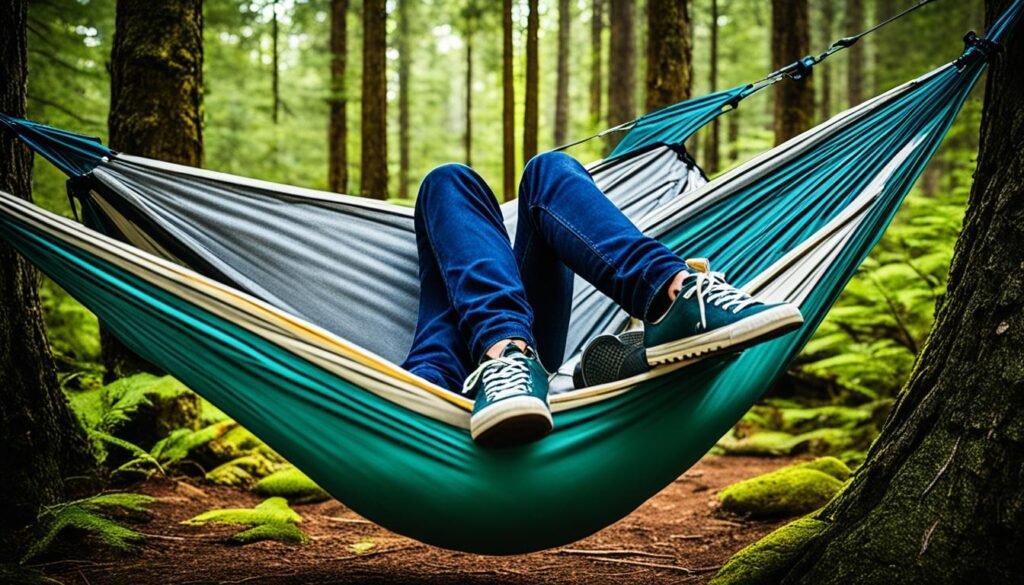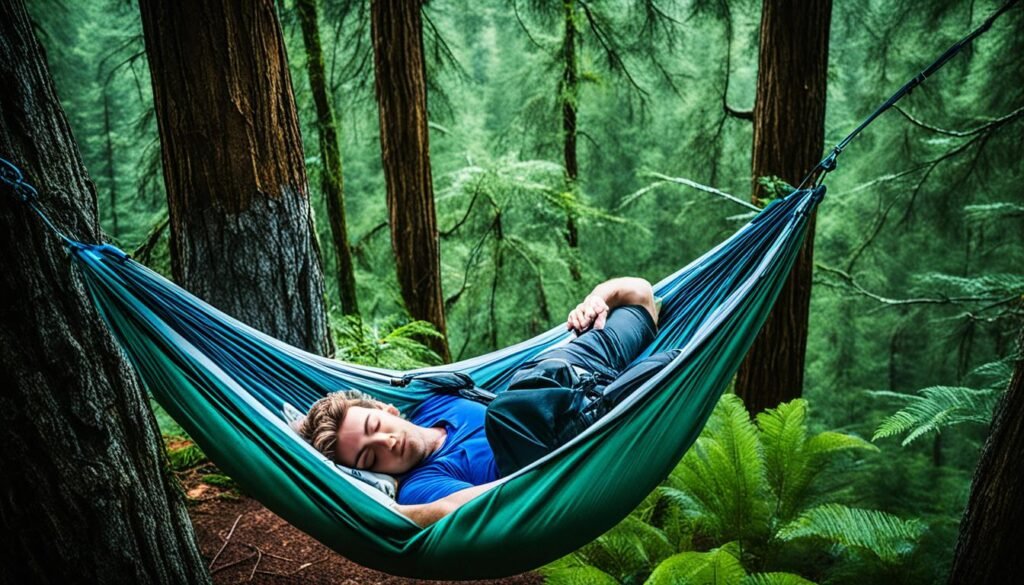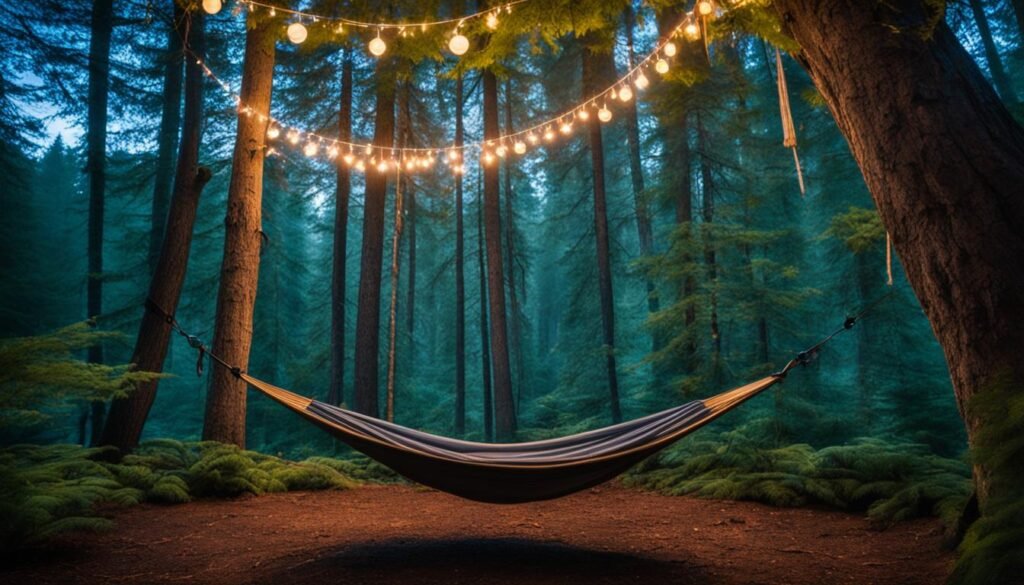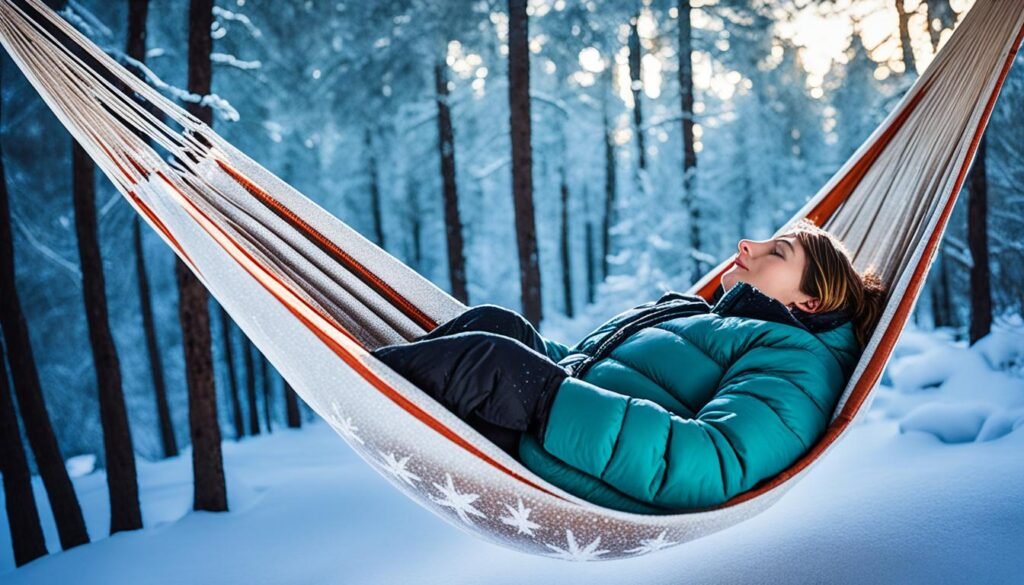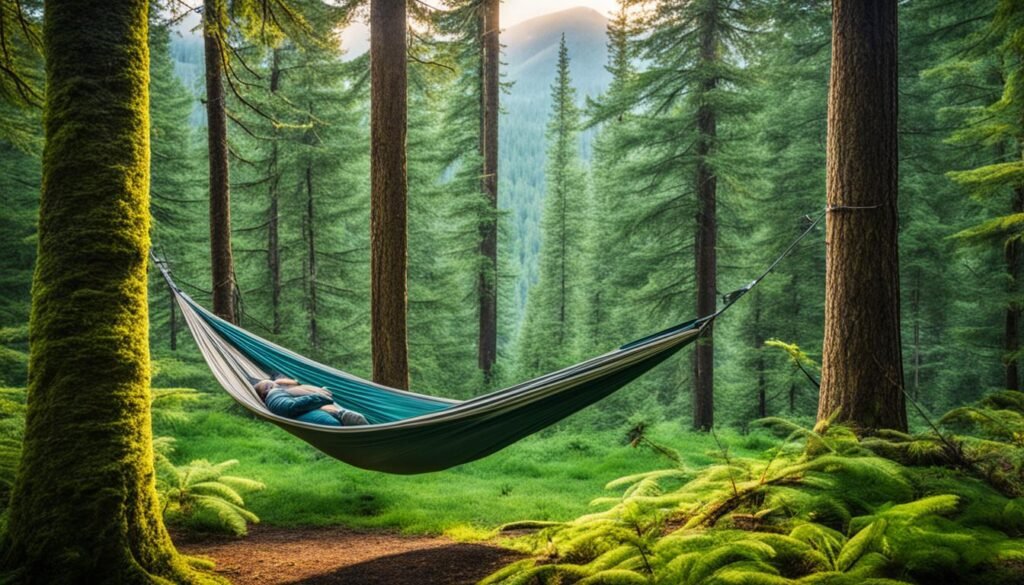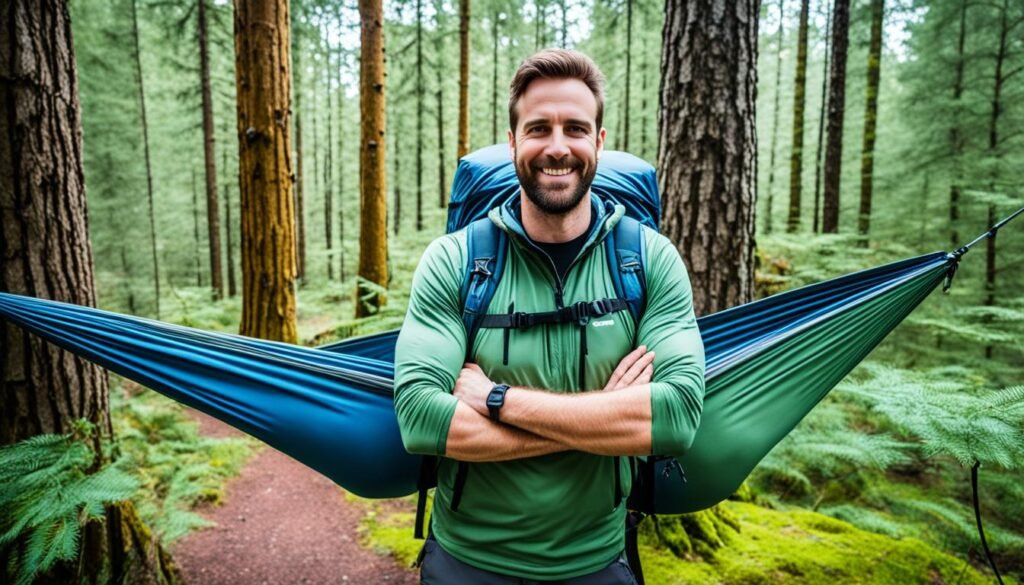For hammock camping, the right tarp size matters a lot. It guards you against rain and keeps you dry. Whether new or experienced, picking the perfect ideal tarp size changes your camping fun.
“Winter” tarps give the best shield. But, any tarp works if it covers well. Make sure the tarp is 6 to 12 inches longer than your hammock on each end. This extra length covers the hammock’s sag.
Now, let’s look at the kinds of tarps for hammock camping. We’ll also see what to think about when picking a tarp size.
Key Takeaways:
- Right tarp size is key for happy hammock camping.
- Winter tarps are tops for all-season camp. But any tarp is okay if it covers enough.
- Your tarp should be 6 to 12 inches longer on each hammock end. It prevents gets wet when you hang.
- Think about the tarp’s weight, coverage, versatility, and durability.
- What you like and your hammock’s length help decide the tarp size.
Types of Tarps for Hammock Camping
Picking the right tarp for hammock camping is key for a good outdoor trip. There are various tarps to choose from. Each provides different protection and coverage.
Full Coverage Tarps
Full coverage tarps are great for camping any time of year. They’re made to give you the most protection. They have extra flaps that close, making a shelter around you.
Hex Tarps
Hex tarps have six sides. They’re a favorite among campers. They cover well and can be set up in many ways.
Diamond Tarps
Diamond tarps are light and cover well. They can be set up in different ways. This keeps you dry and safe from wind.
Square and Rectangular Tarps
Square and rectangular tarps are simple to set up. They protect well against weather. Square tarps are equal on all sides. Rectangular tarps are longer, for more coverage.
Choosing the right tarp depends on your needs and the weather. Think about coverage, setup, and weather when choosing. Always pick durable, quality tarps for the best experience. Now, let’s talk about choosing the right size tarp.
Factors to Consider for Tarp Size
When you pick a tarp size for hammock camping, think about a few things. These include the tarp’s weight, how much cover you want, how it can be used, and its strength. It’s key to balance these aspects to find the best tarp size for you.
Weight matters a lot, especially for backpacking or hiking trips. Big tarps are heavier, which makes carrying your gear harder. But, small tarps are lighter and easier to carry. This makes them great for camping with less gear.
The coverage your tarp gives is really important for keeping you and your stuff safe from weather. Big tarps give more protection against rain, wind, and sun. They’re perfect for long trips because they offer space to cook and hang out. But you might be okay with a small tarp if the weather is mild or you’re not camping long.
Think about how many ways you can set up the tarp. Some tarps let you pitch them in different styles. This is good for different weather and terrain. Look for tarps with many points to tie them up, like loops or grommets. This makes the tarp more useful.
A tarp’s strength is also key, especially for frequent use or in tough places. Tarps made of strong materials like ripstop nylon or polyester are better. They resist tearing and wear. Also, reinforced edges and stitches help a tarp last longer against outdoor conditions.
Keep these points in mind to choose the best tarp size for your hammock camping. Balancing weight, coverage, how you can use it, and toughness is crucial. This will help you pick a tarp that suits your needs and makes camping better.
Importance of Ridge Lines for Tarp Set-Up
Setting up a tarp for hammock camping? Don’t forget the ridge lines. They are very important. They help with many things. They make sure your camping trip is comfortable and successful.
With ridge lines, you can hang your tarp first. This keeps your gear dry while you set up your hammock. This is vital in bad weather like rain or snow. Keeping your stuff dry is key for a good camping trip.
There are two main ridge line types for hammock camping. The first kind is end-only ridge lines. They make set-up simpler by not needing a rope between the tarp tie-outs. The second kind is full-length ridgelines. These go the whole length of the tarp. They make the tarp more stable and strong.
You can set up ridge lines under or over your tarp. It depends on what you need. Setting them up over the tarp is great in bad weather. It gives extra support and keeps you safe from rain, snow, or wind.
Ridge lines are not just for tarps. They are also for hanging things. You can dry wet clothes or hang a bug net. Using ridge lines well can make your camping trip better.
In short, ridge lines are super important for setting up your tarp when camping with a hammock. They make things easier, keep your gear safe, and make your setup stronger. Whether you choose end-only or full-length, using ridge lines is a smart move. They make camping more enjoyable and comfortable.
Guy Lines for Tarp Set-Up
Guy lines are super important for setting up your tarp right. They help you secure your tarp, whether it’s a diamond or asymmetric one. This makes your hammock camping trip go smoothly.
Choosing diamond or asymmetric tarps is common for hammock camping. They usually have two points for guy lines. Attaching guy lines to these points is easy. It helps you set up your tarp quickly.
Guy lines about 6 feet long are the best. They let you set up your tarp in many ways. You can tie it to trees or rocks, or stake it into the ground. This flexibility is great for different camping spots.
Think about the weather when setting up your tarp. In bad weather, like high winds or heavy rain, pitch your tarp low. This reduces wind resistance and keeps you dry.
It’s also smart to adjust your tarp for airflow or to see the views. You can lift the tarp with trekking poles or sticks. This lets you adjust the tarp to make your camping experience better.
For easier use, think about getting retractable guy lines with elastic shock. These help keep your tarp tight, even if it stretches. This means your tarp stays in place, making your trips better.
Summary
Guy lines are key for a good tarp set-up when hammock camping. Using diamond or asymmetric tarps helps make the setup quick. With the right length of guy lines, you can set up your tarp in different ways. Adjust your tarp for air and to enjoy views. And retractable guy lines help keep your tarp tight. With the right setup, you’ll have a great shelter for your camp.

Personal Preferences in Tarp Size
Choosing the right tarp size for hammock camping depends on what you like. Everyone is different in what they need from their tarp. Some people want a tarp that matches their hammock’s length. Others might choose a bigger tarp for more space.
The length of your hammock is key in picking a tarp size. It’s smart to have a tarp that’s longer than your hammock. This way, you get enough coverage. For instance, a twelve-foot tarp works well with an eleven-foot hammock.
“Choosing the right tarp size is about finding the perfect balance between comfort, coverage, and weather protection.”
Pick a tarp size that fits what you want to make your camping better. You might want more room or better protection from bad weather. Your choice should reflect what matters most to you in tarp size.
Comparison of Tarp Sizes for Different Hammock Lengths
| Hammock Length | Recommended Tarp Size |
|---|---|
| 10 feet | 10-11 feet |
| 11 feet | 11-12 feet |
| 12 feet | 12-13 feet |
| 13 feet | 13-14 feet |
The table shows that the right tarp size grows with the hammock length. A bigger hammock needs a bigger tarp for full coverage.
Remember, what you prefer can change based on where you camp and your style. Some campers like light gear and smaller tarps. Others want the most coverage and go for bigger tarps. The best tarp for you gives the comfort and protection you need.
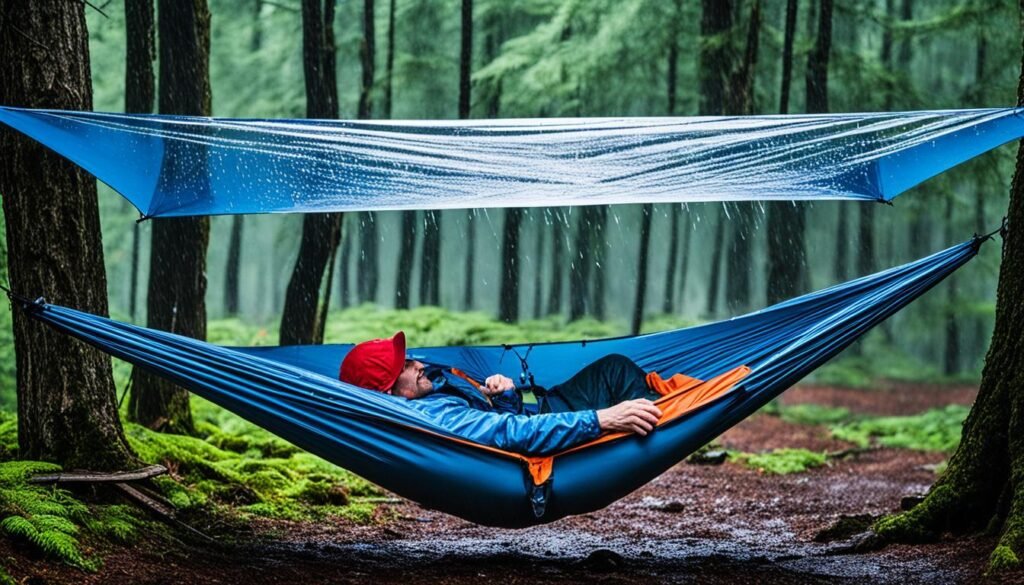
Conclusion
Choosing the right tarp for hammock camping is key. There are many types, like full-coverage for winter and smaller ones for less weight. Think about what you need and the length of your hammock.
Pick a tarp that covers your hammock well. This helps keep you dry and cozy. You can find one that’s heavy for more protection or light for easy carrying. Planning helps you camp with peace of mind.
Before your next hammock trip, take time to pick the right tarp. It can protect you from rain, wind, or sun. Find the best tarp for you, and enjoy a comfortable camping experience.
FAQ
What factors should I consider when choosing the size of a tarp for hammock camping?
When choosing a tarp size for hammock camping, think about the tarp’s weight. Also, think about how much coverage you want. Consider the tarp’s versatility and how tough it is, too.
What types of tarps are recommended for hammock camping?
For hammock camping, full-coverage tarps, or winter tarps, are good. Hex, diamond, square, and rectangular tarps are also recommended.
How do ridge lines benefit tarp set-up for hammock camping?
Ridge lines add support and let you set up the tarp first to keep gear dry. They offer points for drying gear and setting up a bug net in bad weather.
What are guy lines used for in tarp set-up for hammock camping?
Guy lines help set up the tarp in hammock camping. They stabilize the tarp. They let you secure the tarp to nearby supports or stake it into the ground.
How do personal preferences factor into choosing the size of a tarp for hammock camping?
Your own likes matter a lot when picking a tarp size for hammock camping. Some like a tarp as long as their hammock. Others want a longer tarp for more space and protection.
Why is choosing the right tarp size important for hammock camping?
Getting the right tarp size is key for the best cover and protection from weather while hammock camping.


